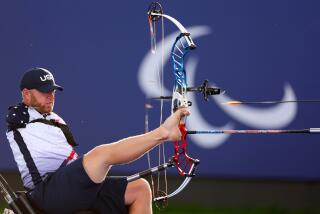Honolulu’s Unique Zen Archery School Teaches Enlightened Way to Reach Target
- Share via
HONOLULU — Where the deep green valley ends at the base of the Koolaus, after Kalihi Street rambles into a rutted one-lane road, is Chozen-ji School of Kyudo. In its elegantly spare wood and paper buildings, 20 students of Koun Suhara learn the Way of kyudo , the ancient Japanese art of Zen archery.
Zen archery, Suhara explained through an interpreter, is not a sport. It is a form of meditation, the Way to the reality within the individual. Jackson Morisawa, acting as interpreter for Suhara, pointed out that this concept is not easily understood in an hourlong encounter. Suhara, the master, when asked how long it takes to learn the Way, said, “Forever.”
A Matter of Control
The elements of Zen archery, he said, are the same as those of meditation--to control the inner energy through breathing techniques and concentration on the proper mental and physical attitude. Already a Zen priest when he began the study of kyudo at the age of 50, Suhara found the training to be an extension of what he already knew.
And what he knew, according to Morisawa, is that the target is not the goal.
“The shooting must be pure, and not a preoccupation with hitting the target,” he said. “Kyudo transcends the shooting of the arrow. Beginners shoot into the makiwara , a bundle of straw, so that they concentrate on breathing and posture, rather than aiming at a target.
“When they are proficient, I put them on the target, and the mind changes. The eagle (target) comes out and they say, ‘I must hit the target,’ and the mind is no longer focused.”
German Exports the Art
Kyudo was introduced to the West by a German professor, Eugen Herrigal, who persuaded a master in Japan to teach him the art. Master Awa, proud of his student, gave Herrigal his favorite bow. He told him, however, that if he were ever to retire, the bow was to be destroyed.
When the time came, Herrigal was unable to bring himself do this, and instead returned it to Awa’s ‘dojo , or school. The bow was sent to Master Anazawa, one of Awa’s students, and Anazawa in turn gave it to his most promising student, Koun Suhara.
Suhara later founded his own school in Kamakura, Japan. He spends part of the year here at the Chozen-ji School, the only Zen kyudo training school outside Asia.
Movements Flow
The movements of kyudo are flowing, slow and deliberate--much like tai chi. The laminated bamboo bow, which is about 10 feet long, is held in the left hand, and in the right hand the archers hold two arrows. One is pointed away from the body, the other toward it.
Walking with a sliding motion, barely lifting the feet from the floor, the archers move one at a time to a point about 35 yards from the target. The notch in the arrow pointing toward the target is slipped into the string of the bow and, with vast concentration and ease of movement, the string is drawn and the arrow flies. Then the process is repeated with the second arrow.
‘A Living Arrow’
In Herrigal’s book, “The Way of the Arrow,” he explains: “The arrow that penetrates in such a state is not the arrow itself, but a living arrow which is the spirit of kyudo. He (the archer) must turn his eyes inward in search of his soul and transcend all external preoccupation with hitting the target. When his spiritual growth allows him to ‘shoot without shooting,’ his character will blend harmoniously with life.”


